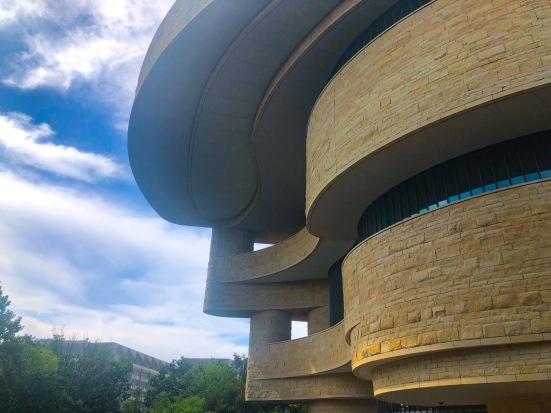
Our Universes focuses on indigenous cosmologies—worldviews and philosophies related to the creation and order of the universe—and the spiritual relationship between humankind and the natural world.
Native Spirituality – I can’t help but find it here, in meditation, reflection, story and connection, in unexplained forces, outside of myself, that I find myself humbled by. I’m surrounded by it – it’s carried by the light breeze that moves through the trees and it’s absorbed by the warm stone walls beside me. Water trickles down a waterfall, and splashes into a shallow pool that collects visitors’ pennies, capturing their hopes and dreams, in the form of whispered wishes that are shared with no one else.
Is this spirituality unable to be explained? After almost a decade of studying Philosophy of Mind and Neuroscience, I doubt it. Is it unexplained, in our high-tech, modern culture? I’d say there’s a good chance of that. Is this spirituality something I personally struggle to understand? Indeed!
To make my way, doing the best I can, I’m visiting a place of stories.
There is a wisdom in ancient storytelling, with real value. Stories teach lessons that encourage living a life full of uninhibited emotion, they tell of strong moral character (or the unfortunate loss of moral character), and they depict lives full of adventure, struggle, questioning, and turmoil. There’s also a simplicity to native stories, in colorful tales that mirror our everyday lives. We discover that the same lessons are available to each of us, in the most ordinary encounters, if we are attentive.

Architecture & Landscapes that Inspire – Five stories tall, the building’s architecture is inspired by nature, with an undulating Kasota Limestone exterior, in a soothing, golden color and texture. It’s oddly warm, and comforting, for such a large structure, made of stone. The dolomitic stone is found in Southern MN, and is rich in Dolomite and Magnesium, which makes it weather resistant. I experience this warmth and welcoming air firsthand, at the National Museum of the American Indian, but I learn about the architectural details on the museum’s website (see below).
The landscaping outside the museum replicates the natural world, as it would have appeared to American Indian people. Plants have been carefully curated, creating natural surroundings that allow visitors to experience the same environment that sustained (and challenged) the people and the cultures the museum honors.
Around the museum, the pedestrian walking path is curved; it seems to flow around the building like an old, wide river, like an old, wise river, one that knows better than to let material objects stand in its way. I follow the path until it bends into a curve that creates a small alcove, and it’s there that I settle into my simple, (almost) daily practice of a 5 min. breathing meditation. Breathe in (possibility), breathe out (negativity).
I’m so focused on my breath, as I should be, that when the gong chimes at the 5-minute mark I remain still, eyes closed, breathing slowly, rhythmically, deeply. The “Ommm” music that accompanies my meditation app continues, in its calming tones. I realize my time is up, and the Insight Timer app is keeping record of how long I’ve been sitting in meditation, focused, and thinking of nothing. I open my eyes and sit for a moment longer, pleased with this museum before I’ve entered its doors.
Entering the Museum – When I first walk into the National Museum of the American Indian (NMAI) I am struck by the wide-open atrium at the center of the building, its circular shape defining a performance area. Today this space is empty. Looking up, toward the matching ceiling, with its concentric circles and a small round skylight in the center, I notice visitors peeking over the edge of the railing, on every floor. I pause, and can imagine the thunderous sound that would echo and reverberate during a performance, time marked by the beating of ceremonial drums, and the collective stomping of dancing, twirling, stomping feet.
The museum opened on the National Mall on September 21, 2004. It is a major exhibition space for Native art and material culture. Performances and educational activities bring the museum, and the cultures it preserves, to life. I’m impressed by its grandeur, in light of its simplicity.
A message, a directive, written across the wall, on top of the primary bank of elevators, guides visitors to start their exploration of the museum on the 4th floor. There is a 15 min. Welcome Video that introduces visitors to the cultural heritage they will find within these walls. Just a couple of minutes into the video, I realize that I’ll never be able to see everything I want to see, in one day.
This is a place of exploration, contemplation, and reflection.

“We are here as a result of the farsighted and tireless efforts of Native culture warriors who demanded that the nation respect and celebrate the contributions that Native people have made to this country and to the world.”
“The NMAI cares for one of the world’s most expansive collections of Native artifacts, including objects, photographs, archives, and media covering the entire Western Hemisphere, from the Arctic Circle to Tierra del Fuego.”
The NMAI is also dedicated to acting as a resource for the hemisphere’s Native communities and to serving the greater public as an honest and thoughtful conduit to Native cultures—present and past—in all their richness, depth, and diversity.” (NMAI website)
What is My Place in the Universe? – The impact of the museum stems, in part, from the perpetual, modern inability to answer this question. Native cultures shared our curiosity and interest in this question, but they found solutions – they had answers. The answers were as diverse as the cultures. Were they the right answers? Does it matter?
The 4th floor of NMIA is dominated by an exhibit that will remain in place until late 2021: Our Universes: Traditional Knowledge Shapes Our World. Creation stories, organized around the solar year, explore the views of indigenous peoples from across the Western Hemisphere.
Stories are creatively passed from one generation to the next, and the modern people of these cultures live out the spirit and values of times past. Through art, language and tradition, they express the wisdom of their ancestors in their daily lives.
Spirituality is celebrated, so that it will live on.
Connection to the natural world is paramount, so spending time in nature is encouraged, almost mandated. Wisdom and Curiosity exist side-by-side. As we learn more, scientifically, about the world we live in, and have a more intricate, robust understanding of why things happen the way they do, I hope this curiosity remains. I hope the deep, heart-felt wisdom of these cultures still has a place.
“Our Universes focuses on indigenous cosmologies—worldviews and philosophies related to the creation and order of the universe—and the spiritual relationship between humankind and the natural world.” (NMAI website)

Practical Tips for your Visit – As part of the Smithsonian, visitors can experience the museum at no cost. Well, there’s no admission fee, thanks to federal appropriations and income generated from gifts and private investments (“trust funds”) – without planning to, visitors might end up spending a dollar or two in the upscale cafeteria or the expansive gift shop.
- Plan your day with snacks and meals outside of the museum, unless you’re eager to spend $20+ on cafeteria-style dining. There are numerous food stations, offering traditional recipes and using ingredients that native people would have had ready access to, but many of the lunch entrees are $18, $23, even $27. A small cup of bison chili with fry bread, for $11, was a steal! Tasty and filling, it served its purpose as a snack, just before noon, but did not take the place of lunch.
- Bring a refillable water bottle! An 8 oz can of Coke Zero is overpriced, at $4. Water is better for your health anyway. I had my collapsible Hydaway water bottle with me, and refilled it all weekend long. Every Smithsonian museum I visited had restrictions on food and drink, except for water, in resealable containers.
- Plan to spend a full day, or two. If you’re open to the reflection and contemplation the museum inspires, or moved by beautiful architecture and landscaping, there’s too much to see in ½ a day, or a few hours. You can experience bits of the museum in small chunks, a little bit at a time, if you are a frequent traveler to Washington D.C. Otherwise, plan to give the museum the time it deserves.
- Bring the spirit of the museum home with you! Known for intricate and colorful artistry, in the form of beaded vests, braided tassels, toys made of animal hides, and painted tepees, native cultures have produced an array of items available for purchase. If you’re short on time, by all means visit the smaller gift shop on the first floor, next to the coffee stand. If you have more time, or a true interest in the art of native cultures, plan some time to wander through the large gift shop that represents of these cultures.

My spiritual takeaway from this unique museum was a genuine sense of curiosity, about things I know little about. Casually, and without much conviction, I’ve motioned toward the sky on occasion, telling friends that the Crane is my “spirit animal,” watching over me and bringing good luck. But don’t good things seem to happen in my life, after I’ve seen a Crane fly overhead. . . ?
Perhaps the sight of the Crane puts me in an open mindset, so I’m receptive to the good that was already there in the first place. I catch myself thinking, “Oh, something good is bound to happen today,” and then I patiently wait for it to happen. More often than not, something good does happen.
My literal takeaway item was a small book of reflections: Native Wisdom for White Minds: Daily Reflections Inspired by the Native Peoples of the World, by Anne Wilson Schaef. The author’s website reads: “Anyone ready to move from feeling separate to a profound sense of connectedness, from the personal to the global, will find the path in this mind-expanding, deeply spiritual book.”
It can’t hurt to open my mind to new ideas, new ways of viewing the world. They are actually quite old views, after all, with nuggets of wisdom in them.
NMAI Vision
Equity and social justice for the Native peoples of the Western Hemisphere through education, inspiration, and empowerment.NMAI Mission
In partnership with Native peoples and their allies, the National Museum of the American Indian fosters a richer shared human experience through a more informed understanding of Native peoples.
Join me on my next adventure,
~ Kat
Related Links:
The National Museum of the American Indian: https://americanindian.si.edu/
Smithsonian: https://www.si.edu/
Insight Timer app: https://insighttimer.com/
Native American Crane Mythology: http://www.native-languages.org/legends-crane.htm
Native Wisdom for White Minds: Daily Reflections Inspired by the Native Peoples of the World, by Anne Wilson Schaef: https://annewilsonschaef.com/books/native-wisdom-white-minds/
Anne Wilson Schaef (author): https://annewilsonschaef.com/books/native-wisdom-white-minds/








